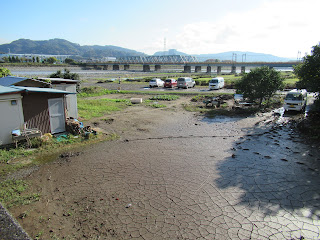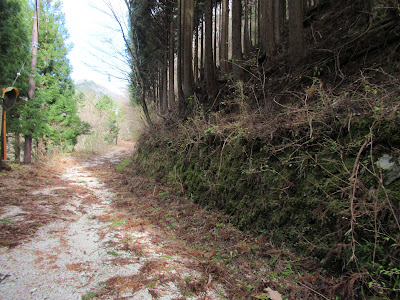Every winter, City of Yokohama invites registered city forest volunteers to participate in a line census of wild birds in Niiharu. FYI, “a line census of birds” is to record species and number of bionts observed roughly 50m radius around a researcher who walk leisurely along a regular route. Ideally, a census would be done once in a certain period of calendar at the regular time of the day, like “a day of every January, between 10:00-14:00.” In this case, the invitation for volunteers is once a year (a bit too long interval, admitting) every mid-winter, i.e. late January or early February, around noon. The location is in Niiharu Citizen Forest 新治市民の森. There are two routes to cover: one starts from the admin office for Niiharu Satoyama Park 新治里山公園, adjacent to the Citizen Forest, and proceed to the west along the houses and veggie fields facing the Citizen Forest to the south (i.e., from B1 to B2, then to B3 of the map). We enter further to B-10 along the organic rice paddies cultivated by a volunteer group, the Organization for Promoting Niiharu Satoyama Community 新治里山「わ」を広げる会 (; please see my post on March 4, 2016). Another route for the census begins at the admin office, and moves to the east walking the community road running in front of Niiharu Elementary 新治小学校 to meet with Ipponbashi Bridge 一本橋 over Umeda River 梅田川. We then turn right to go south along the River up to the water reservoir and return to the admin office taking the course to the north running in the mixture of houses and farms. I attended this event for 2018, 2019, and this year 2020. January 2020’s result turns out to be a bit odd.
 |
| A
scenery from the course of line census returning from the Umeda River reservoir |
First, Good news. Around 7:30 in the morning of our event, our leader-cum-lecturer Mr. Ken’ichiro Jimbo found 2 Northern gashawk played a love dance above the forest. Niiharu was known to be amazing as home for hawks and owls amid the housing complexes of suburban Tokyo. Then, some 7 or so years back, one too-enthusiastic photographer pitched a tent below the nest of a hawk family to take “best shots of lovely eyas in Megalopolis,” with his million yens’ single lens reflex. You see? Northern gashawks are very prudent birds. When they found something shiny near their home, they will not approach to their nest. Photographer’s gorgeous lens twinkled incessantly below their house reflecting sun light. Parent hawks could not come back to incubate their eggs. City officers, police, and volunteers for Niiharu Forest begged the guy to leave the site for the sake of birds. He did not yield, claiming (1) his camping site was in a public land, (2) this is a free country so that without legal endorsement no one was able to force him out to remain temporarily in a public land (; at least he did not “live” there), and (3) Japanese Constitution guarantees the freedom of expression so that his effort to take photos without invading another human being’s right was completely legal. Er, OK. The time was up for the eggs of hawks. They all died, and the parent birds left the forest. Since then, mentioning about the existence of Northern gashawks in Niiharu became a sort of taboo. “You know? In this age of SNS and Instagram, telling the observation of hawks in such-a-such point of Niiharu is the first act of destroying nature.” Pathetic … Though, about 3 years ago, people visiting and caring Niiharu Forest started to notice the hawks fling over the forest again. In 2018, volunteers identified a new nest of Northern gashawks in Niiharu. (I will never tell you where in this roughly 80ha area.) Still we have not known if the new nest is a home for babies. If a couple did a dance, we may welcome newborn hawks this spring! This time, we humans will be prudent as the hawks …
 |
| Somewhere in that forest of Niiharu, there is home for Northern gashawks, and owls. |
Raptors are important for a forest like Niiharu. The species sit on the pinnacle of food chain especially in forests of suburbs. If they can rear their kids in the place, it means the area has enough food, aka biodiversity, with creatures in the lower stratum of the pyramid. Now, Northern gashawks come back. Our forest is showing its robustness to preserve the environment! … Maybe. No man is an island. Niiharu Forest, floating in the ocean of buildings in Megalopolis Tokyo, is not an island either. Birds, especially itinerant birds, tell us something curious this year about that.
 |
| Cute, isn’t he? A male Bull-headed shrike I’ve found in Niiharu. |
On that census day, we started our walk leisurely as it was supposed to be. You see? Birds are sensitive bunch. If they find us nervous or excited, they fly away from us. In order to identify species, we need a certain level of proximity to them even with good binoculars and monocles. So, we began our expedition calmly from the admin office. That was a strangely warm January day, not sunny but not rainy either. The route went first in front of the houses of the locals. We met several familiar Brown-eared bulbul, crows, White-cheeked starling, Oriental turtle dove, and Japanese tit. Sparrows were coming and going between the veggie field and houses. When we reached the full body of the forest, Japanese pygmy woodpecker and Warbling white-eye started to appear … They are in Niiharu Forest year-round. During winter when many trees become only with boughs and trunks, it becomes easier for us to notice them. Then, here came a Daurian redstart. Oh, hello, long-distance travelers! How was the Continent last summer? Did you have a nice August there? Er, what happened with your fellow traveler, Rustic bunting? We haven’t seen them yet …
 |
| City dwelling White-cheeked starling in Niiharu |
 |
| Japanese pygmy woodpecker in Niiharu this January |
 |
| Female Daurian redstart |
 |
| Grey heron. I think he is magnificent … with impressive decorative feathers. |
 |
| Common kingfisher lady with charming rouge of her lower beak. |
Our guess is, those birds which usually pass the winter in Niiharu do not find their summer home much cold this year. Well, they may have left their dacha as usual, but could find a nice place nearer and decide to stay there. If they can manage the winter without flying long distances, why bother to venture out thousand miles with lots of dangers along the way? Niiharu Forest may have restoring its biodiversity very locally. But something much bigger can be happening in this planet … Don’t you think?
< What we've found during 2-hour line census in Niiharu Forest>
* Birds in blue font are migratory coming from overseas.
* Birds in green font are wandering species visiting warmer places domestically during winter.
 |
| Ubiquitous Brown-eared bulbul |
If you find a problem in Niiharu Forest, please make a contact with
Office for the Park Greeneries in the North 北部公園緑地事務所
Yokohama Municipal Government Creative Environment Policy Bureau 横浜市環境創造局
Phone: 045-311-2016
FAX: 045-316-8420
Niiharu Administrative Office / Satoyama Exchange Center 新治管理事務所・里山交流センター
Phone: 045-931-4947
Fax: 045-937-0898
Email: info@niiharu.jp
http://www.niiharu.jp/
If you find environmental issues in Kanagawa Prefecture, please make a contact with
Kanagawa Natural Environment Conservation Center 神奈川県自然環境保全センター
657 Nanasawa, Atsugi City, 243-0121
〒243-0121 厚木市七沢657
Phone: 046-248-0323
You can send an enquiry to them by clicking the bottom line of their homepage at http://www.pref.kanagawa.jp/div/1644/
657 Nanasawa, Atsugi City, 243-0121
〒243-0121 厚木市七沢657
Phone: 046-248-0323
You can send an enquiry to them by clicking the bottom line of their homepage at http://www.pref.kanagawa.jp/div/1644/

















































